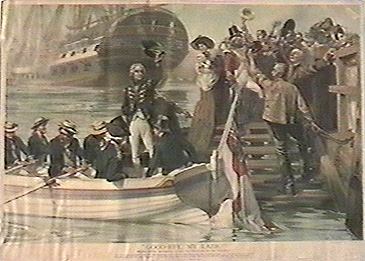| Title: |
Good-bye, My Lads! (Admiral Nelson leaving Portsmouth for Trafalgar) |
| Designer: |
Roe, Fred (London, 1864 - 1947) |
| Date: |
1905 |
| Medium: |
Original Chromolithograph |
| Publisher: |
The Illustrated Sporting and Dramatic News |
| Printer: |
G. Whitehead and Company, London |
| Note: |
Fred Roe: A fine English genre painter and illustrator,
Fred Roe studied art at Heatherley's and with J. Seymour Lucas. He first
exhibited his art at the prestigious Royal Academy in 1877 and was elected
to the RBA in 1895 and to the Royal Institute of British Painters in 1909.
During his career, Roe was best known for his large historical compositions
set in period costumes. Also he later became a leading expert and collector
of antique furniture and was the author of a still standard reference
book, A History of Oak Furniture (1920). |
| |
Good-bye, my Lads! depicts Admiral Nelson leaving
Portsmouth for Trafalgar, England's most famous naval battle. At Trafalgar,
Nelson confronted the combined Franco-Spanish fleet of Napoleon and (although
greatly outgunned) completely routed his adversary. At the end, France
lost fifteen of its thirty-three ships while England lost none. English
casualties, in fact, amounted to only 449 men. Unfortunately, England's
greatest admiral was one of them. |
| |
The Chromolithograph: The exacting art of colour
printing from lithographic stones originated in Europe during the middle
1830's. The first English chromolithograph was created almost ten years
later. During the following seventy years thousands of these original
colour prints were framed to adorn the walls of Victorian parlours, with
images ranging from the fine arts to botanical and fashionable designs
and advertisements. These colour prints revolutionized the art industry.
By 1870, large and profitable publishing houses sprang up in almost every
major American and European city. The practical advances of photomechanical
methods, however, sounded the death knell for the chromolithograph in
the early years of the twentieth century. |
| |
Today, chromolithographs (especially large examples such
as this) have became very scarce. The major blame falls on the ruinous
methods of framers from the period as they invariably employed the most
acidic and damaging materials at hand. The result is that the vast majority
of these important works of art have quite literally rotted away in their
frames. |
| Size: |
22 1/2 X 32 (Sizes in inches are approximate,
height preceding width of plate-mark or image.) |
| |
Matted with 100% Archival Materials |
| Condition: |
Printed upon thick wove paper and with full margins as published
in London, England, in 1905. Containing slight creasing, as usual, else
a magnificent impression and in excellent condition throughout. To find
such a large chromolithograph without significant discolouration or staining
is most rare. Good-bye, My Lads! (Admiral Nelson leaving Portsmouth for Trafalgar) is one of the greatest original
chromolithographs one will find. |
| Price: |
Sold - The price is no longer available. |
| Important Information: |
The artist biographies, research and or information pertaining to all the original works of art posted on our pages has been written and designed by Greg & Connie Peters exclusively for our site, (www.artoftheprint.com). Please visit us regularly to view the latest artworks offered for sale. We will soon be posting an update of our most recent research and include the biographical and historical information pertaining to our next collection of original works of art created by artists throughout the centuries. We hope you found the information you were looking for and that it has been beneficial.
Our Gallery, (Art of the Print / www.artoftheprint.com) guarantees the authenticity of every work of art we sell 100%. Full documentation and certification is provided. We offer a wide selection of international fine art dating from the early Renaissance to the contemporary art period. |




![]()
![]() or
phone Greg & Connie (905) 957-6666
or
phone Greg & Connie (905) 957-6666